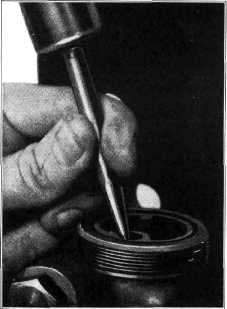1942 - 1947 CHEVROLET SHOP MANUAL
Section 2 - Frame
|
|
|||
|
2-15 |
|||
|
|
|||
|
When
assembling end cap, place a small amount of grease between end cap and steel
spacer.
9. Fill
shock absorber to capacity with fresh G.M. Shock Insulating Fluid. While filling
move arm through complete
strokes to expel the air from
unit.
10. Replace other end cap and rotate fixture
until arm is in same position
as it is mounted on car.
11. Remove filler plug and allow fluid to drain
down to the level of the
reservoir to allow for normal
expansion of the fluid.
12. Replace filler plug, using new
gasket.
Double-Acting Opposed, External Valve Type
Relief valves of this type shock
absorber may be removed by removing
valve cover plugs shown in Fig. 13 and picking valves out with
hooked tool or piece of wire.
DISASSEMBLY
Single-Acting Type
1. Remove shock absorber from car and mount
on fixture in a vertical
position, cover end up.
2. While holding shock absorber arm firmly in
vertical position, to hold
piston in cylinder, remove cover screws and
cover. |
3. Move arm toward piston side of housing so
that the piston spring is
compressed. Insert Delco Hold Down Tool No. 515, leg down, loop out,
over edge of shock absorber on
piston side, and slide around
edge of opening until the loop is locked under the shoulder at the corner of
the shock absorber. Then the
arm may be released.
4. Remove shock absorber from fixture and place
under arbor press. Move arm away from piston so that the cam is turned up, exposing the
piston. Place short length of
cold rolled stock between press
and piston as in Fig. 25; compress piston spring slightly to remove hold
down hook.
5. Raise press slowly until piston is fully
extended. Then lift piston and
spring out.
Double-Acting Parallel Cylinder Type
The parallel cylinder type shock
absorber should not be disassembled
as the internal parts such as the pistons, piston springs, cam, or intake
valves are not serviceable.
The only serviceable parts of this shock absorber are the cover, cover
gasket, cover screws, rebound
valve, compression valve, valve
nuts and gaskets, and filler plug and gasket. If replacement of pistons,
piston springs, intake valve
or any internal parts becomes necessary, complete shock absorber replacement is
required. |
||
 |
|||
 |
|||
|
|
|||
|
Fig. 25—Using Arbor Press to Compress Piston
Spring |
Fig. 26-Piercing Piston Screw Plug |
||
|
|
|||